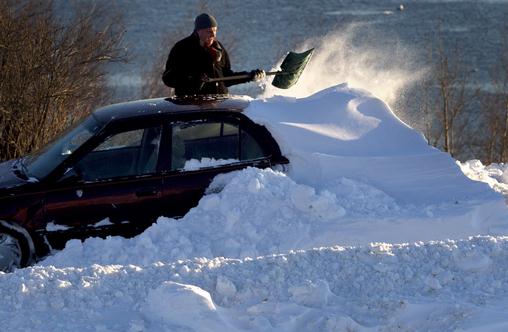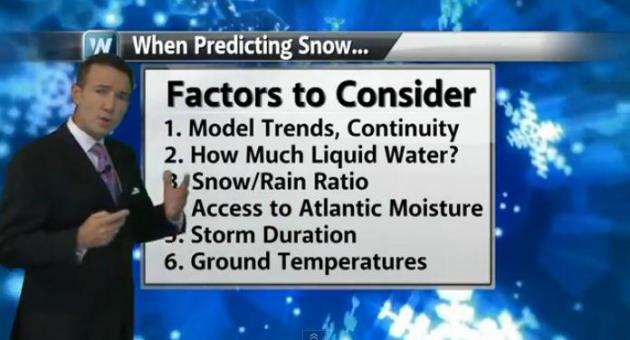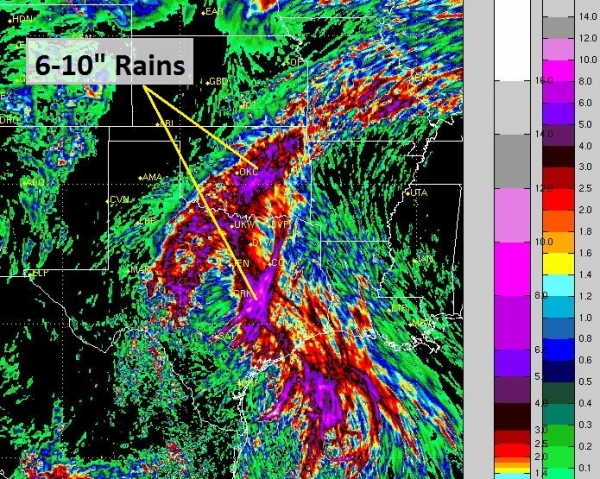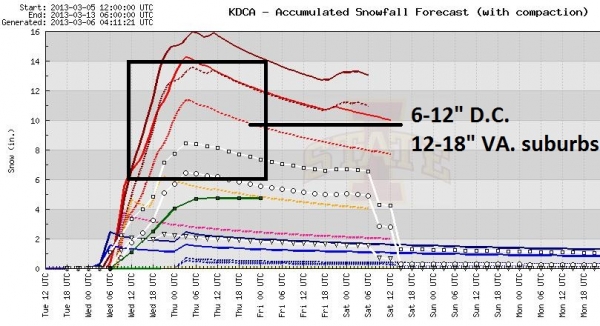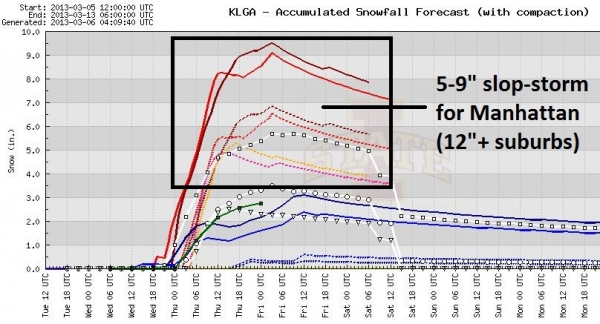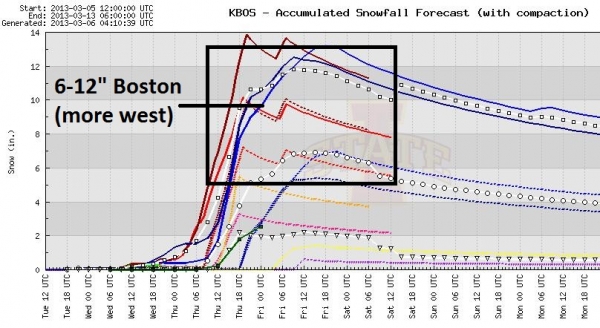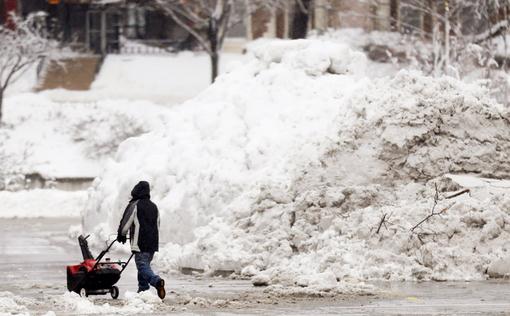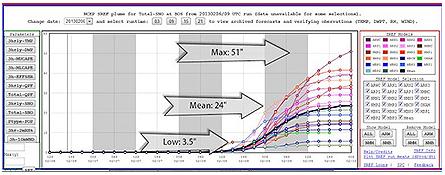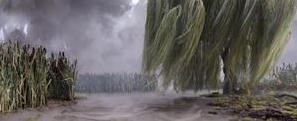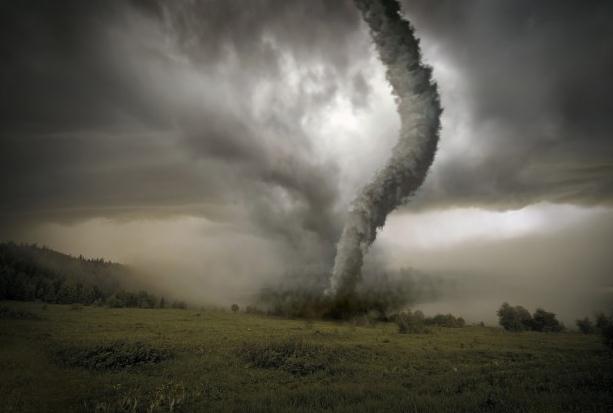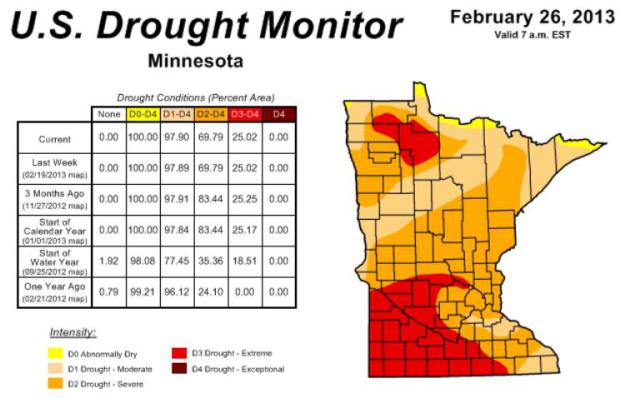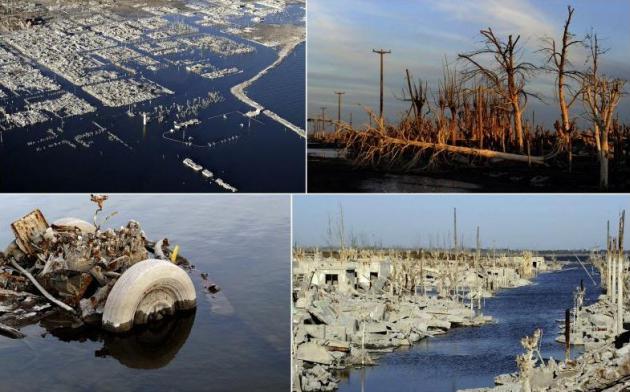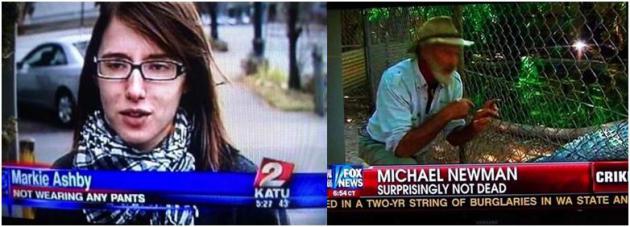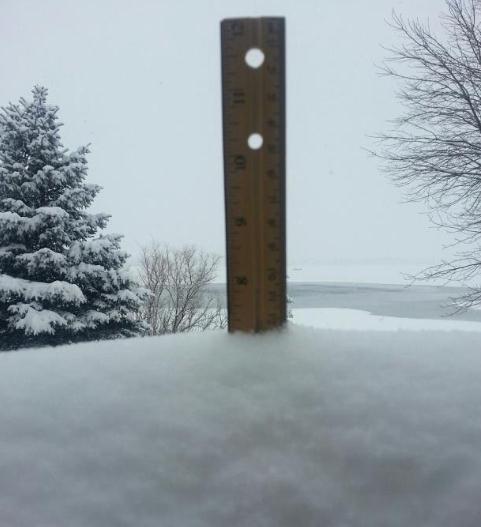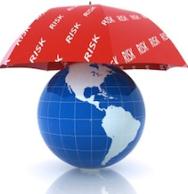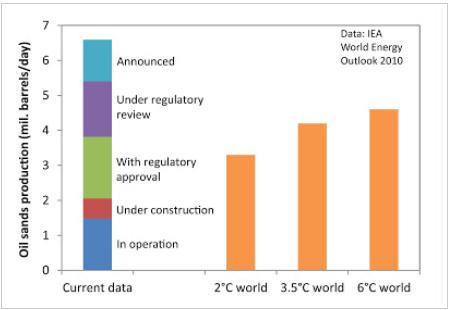Vague Hints of Spring
Spring is coming. How do I know? The Auto Show
kicks off this weekend. I'm getting stacks of swimsuit catalogs in the
mail. And yesterday, in spite of 28F, roads became wet - evidence of a
higher sun angle. Oh, and it may rain here Saturday, so get out and play
in that new snow ASAP.
Daffodils won't be poking up in your yard
anytime soon. I've gone on record predicting a cooler than normal March;
nothing like 2012. That may bode well for our drought, but I suspect a
very active severe storm season this year: more hail, high winds &
tornadoes, as the jet stream sets up farther south. I hope I'm wrong on
that call.
I have family in Washington D.C. My brother in
law describes our nation's capitol as "a perfect combination of northern
charm and southern efficiency." A forecast of flurries can spark panic.
A few inches of slush often triggers a stampede for groceries. A foot
of heavy, wet, concrete-like snow may shut down D.C.'s suburbs today.
New York and much of New England may see similar amounts, thanks to a
coastal storm tapping a fresh jolt of Atlantic moisture.
Breaking News.
That's one of many reasons I love Minnesota.
6-10" snow? No big deal. We groan (or cheer), but we don't make excuses.
Life goes on.
How Much Fell? It was a fairly wide swatch (200
miles, give or take) of 6-10" of snow. Here's a good overview of
snowfall amounts from March 4-5, statewide, courtesy of the
Twin Cities National Weather Service office.
...MINNESOTA...
MINNESOTA CITY 11.7"
LAKE CITY 1 SE 11.5"
SPRING VALLEY 3 E 10.6"
KELLIHER 10.0"
RED WING 9.4"
STEWARTVILLE 9.3"
SQUAW LAKE 9.0"
STACY 9.0"
WASKISH 9.0"
FOUNTAIN 2 W 8.5"
GONVICK 8.5"
FARIBAULT 8.0"
KIMBALL 3 N 8.0"
ROCHESTER 3 NE 7.5"
ST JAMES 7.5"
MINNEAPOLIS 2 NE 7.1"
What A Winter. Here are some interesting snow factoids for record snowfall amounts this winter, courtesy of
UCAR:
Heaviest snowfall ever recorded
• Portland, Maine (
31.9”, February 8–9)
Second heaviest
• Concord, New Hampshire (
24.0”, February 8–9)
• Wichita, Kansas (
14.2”, February 20–21)
Third heaviest
• Amarillo, Texas (
19.0”, February 25)
Fifth heaviest
• Boston, Massachusetts (
24.9”, February 9)
Photo credit above: "David Tripp digs
out his car in Portland, Maine, Sunday, Feb. 10, 2013, after it was
partially buried by drifting snow in a blizzard dumped that a record
31.9 inches of snow on the city." (AP Photo/Robert F. Bukaty)
"Snowquester": Why This Forecast Is Even Tricker Than Usual.
The same clipper than dumped 6-10" on much of the metro over 2 days
will whip up a coastal storm later today, putting down a blanket of
heavy, wet snow from D.C. to Boston. The forecast is rarely black or
white, but rather some nebulous shade of gray, especially this time
around. Details in today's edition of
Climate Matters, courtesy of WeatherNation TV: "
After
blanketing parts of the Midwest, a clipper is creeping closer to the
Mid Atlantic and Northeast. How much snow will cities like DC and New
York see? Meteorologists are divided. WeatherNation Chief
Meteorologist, Paul Douglas offers his thoughts on the storm, plus
explains all of the factors involved when predicting snowfall amounts."
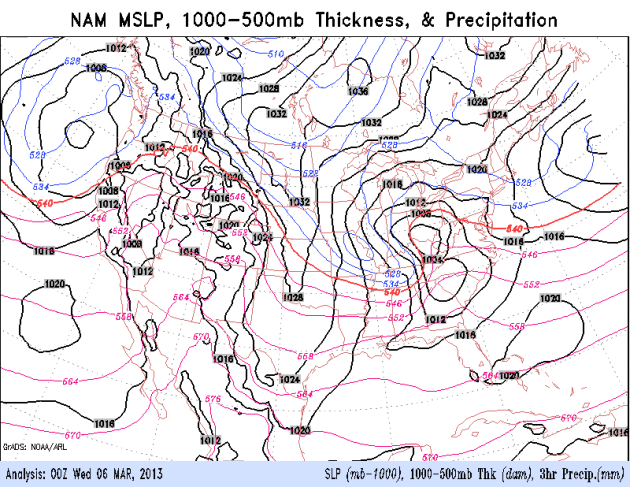
Latest Briefing from our
Alerts Broadcaster Division:
* Potential for heavy wet snow has increased a few more notches in
Washington D.C. - 6-12" of sloppy wet snow possible, with well over a
foot for the northern/western suburbs of D.C. Considering that 1-3" is a
tragedy in D.C. this amount of snow should create something close to
total paralysis in our nation's capitol, land and air (I expect all 3
D.C. airports to be closed to air travel much of Wednesday). Moderate to
high risk of power outages.
* Risk of heavy wet snow has increased in New York City. A plowable
snowfall is likely, starting late Wednesday afternoon and continuing
into Thursday. Some rain may mix in, but some 5-9" amounts are possible
in Midtown, with over a foot for suburbs.
* Boston will see significant snow, with a huge variation from
Boston Harbor to the western suburbs, but some 6-12" amounts are
possible by Friday morning. Winds will blow from the north/northeast,
preventing warmer air off the Atlantic from turning the storm to rain.
Latest Numbers. Everything in red is forecast to
see at least 8" of snow Wednesday into Friday morning, including much
of the D.C. area, metro New York and Boston. Some 12-24" amounts are
predicted for northern Virginia, and from near Providence into
southeastern Massachusetts. To be honest I'm not sure why NOAA hasn't
extended Winter Storm Watches or Warnings for the New York City area. I
predict the Winter Storm Watch for Boston will be quickly upgraded to a
Winter Storm Warning, meaning heavy snow is imminent.
High-Res Models. I'm not convinced Washington D.C.
will pick up 12-16", but the 12km RPM model above seems to think so.
West of I-270 in Maryland, from Dulles International to Leesburg?
Absolutely. This model predicts slightly less snow for Manhattan (4-8"
slush) but some 10"+ amounts for the suburbs. Boston picks up over a
foot of snow. Again, we're looking for consistency between the models,
and a convergence of solutions from run to run. Confidence levels
continue to rise: this will be a plowable snow for not only D.C., but
much of New Jersey, New York City and New England.
Snow won't
be as heavy or widespread as the February 9 blizzard, but this storm is
still capable of disrupting operations for at least 36-48 hours.
A Rude Awakening For Washington D.C. Only 1.5" of
snow has fallen so far this winter in D.C. Which will make today's
heavy wet snowfall even more memorable. I expect widespread disruptions
to travel in the D.C. area today with a moderate to high risk of power
outages.
Classic March Slop-Storm for New York City. Rain
may mix in with the snow from time to time, but a north/northeast wind
at the height of the storm should keep much of the precipitation
falling as heavy wet snow, with the greatest potential for accumulation
Wednesday evening into Thursday afternoon. Plowable, but not crippling
for NYC, with a moderate risk of power disruptions, especially suburbs.
Snow Potential Increases In Boston. I still expect
huge snowfall variations in the Boston metro area, a few inches for the
Cape, but enough to shovel and plow for much of Boston, well over 1
foot for the western and southwestern suburbs. The heaviest snow comes
during the day Thursday.
Coastal Flood Threat. NOAA has issued Coastal Flood
Watches & Warnings for coastal New Jersey and the NYC area,
coinciding with high tide. Minor to moderate flooding of lowland areas
(within 6 feet of sea level) is possible. Details:
...WIDESPREAD MINOR TO LOCALIZED MODERATE COASTAL FLOODING DURING
WEDNESDAY AFTERNOON AND THURSDAY MORNING HIGH TIDE CYCLES...
SOUTHERN WESTCHESTER-BRONX-NORTHEASTERN SUFFOLK-NORTHERN QUEENS-
NORTHERN NASSAU-
...COASTAL FLOOD WARNING REMAINS IN EFFECT FROM 3 PM TO 8 PM EST
WEDNESDAY...
...COASTAL FLOOD WATCH REMAINS IN EFFECT THURSDAY MORNING...
* LOCATIONS...ALONG FAR WESTERN LONG ISLAND SOUND AND PECONIC
AND GARDINERS BAYS.
* TIDAL DEPARTURES...BETWEEN 3 TO 4 FT ABOVE ASTRONOMICAL TIDES
WEDNESDAY EVENING...AND 2.5 TO 3.5 FT THURSDAY MORNING.
* BEACH EROSION...BREAKING WAVES OF 2 TO 5 FT ACROSS WESTERN
LONG ISLAND SOUND AND 4 TO 8 FT ACROSS THE TWIN FORKS OF LONG
ISLAND WILL LOCALLY ENHANCE INUNDATION.
* TIMING...MINOR TO MODERATE COASTAL FLOODING IS EXPECTED DURING
THE TIMES OF HIGH TIDE WEDNESDAY EVENING AND THURSDAY MORNING.
* IMPACTS...WIDESPREAD MINOR TO LOCALLY MODERATE FLOODING OF
VULNERABLE SHORE ROADS AND/OR BASEMENTS DUE TO HEIGHT OF STORM
TIDE AND WAVE ACTION. SOME ROAD CLOSURES MAY BE NEEDED.
ISOLATED STRUCTURAL DAMAGE MAY BE OBSERVED.
Summary: Snow is already piling up in Washington
D.C., and conditions will become increasingly treacherous Wednesday PM
and Wednesday night across the New York City area as a classic
Nor'easter hugs the coast. Heavy wet snow overspreads Boston late
Wednesday night into Thursday. This will be a plowable storm for much
of the New York City area, potentially crippling for the
northern/western suburbs of Washington D.C. and the far western suburbs
of Boston, possibly Providence as well. Expect major disruptions to
air and land travel, with a moderate risk of power outages, due to high
water content in the snow. Although not as severe as the blizzard that
struck in early February this will be the biggest storm in Washington
in 3 years, and one of the 3-4 biggest snowfalls of the last 5 years
from the suburbs of New York to Boston.
Extreme Weather Makeover: Has Abnormal Become The New Normal? Good question. The short answer is yes. Rick Montgomery has the story at
The Kansas City Star; here's an excerpt: "
Those
drought-damaged evergreens outside? Regional climatologists say to
expect more in the years ahead. And the surreal mounds of snow now
hiding shrubs that barely survived summer’s heat? Get used to that, too.
It seems contradictory, this weird weather whiplash. But just consider
the last couple of years in the nation’s midsection. Floods unleashed
by record inflows into the Missouri River basin in early 2011. Then
sudden and prolonged dryness. Now 20 to 25 inches of snow heaped on
Kansas City in the most dramatic, back-to-back smacking delivered by any
winter week that many of us can recall. Yet to experts who study
climate change models, it makes sense. Think extreme..."
Photo credit above: "
A man pushes a snowblower around a
giant pile of snow left by road crews in the Country Club Plaza shopping
district of Kansas City, Mo., Tuesday, Feb. 26, 2013. For the second
time in a week, a major winter storm paralyzed parts of the nation's
midsection Tuesday, dumping a fresh layer of heavy, wet snow atop
cities still choked with piles from the previous system and making
travel perilous from the Oklahoma panhandle to the Great Lakes. The
weight of the snow strained power lines and cut electricity to more
than 100,000 homes and businesses. At least three deaths were blamed on
the blizzard." (AP Photo/Orlin Wagner)
Read more here: http://www.kansascity.com/2013/03/02/4096394/extreme-weather-makeover-has-abnormal.html#storylink=cpy
Read more here: http://www.kansascity.com/2013/03/02/4096394/extreme-weather-makeover-has-abnormal.html#storylink=cpy
Predicting The Snows That Matter Most. In 1977 there
was one weather model, the LFM. Now there are hundreds, even thousands
of weather models. What to believe, when, and why? This article from
UCAR delves into how ensemble modeling has revolutionized weather forecasting; here's an excerpt: "...
One
reason why these eye-popping snowfall totals didn’t come as a surprise
is the growth of ensemble prediction. Little more than a decade ago,
U.S. forecasters had access to only a handful of fresh runs of computer
models every few hours to guide their snow forecasts. Today, there’s
not only a broader range of models, but some of these models are run
multiple times, side by side, with small changes in the starting-point
conditions that mimic the gaps in our less-than-perfect weather
observing network. Such ensembles are helping forecasters deal with
such high-impact threats as the “Snowquester” winter storm expected to
strike the Washington, D.C., area this week..."
Severe Weather Preparedness Week. March 3-9 marks
the official (nationwide) kick-off of Severe Weather Preparedness Week;
here are some timely details and reminders of 2012 from
FEMA: "
Every year, thousands of people are impacted by severe weather threats such as tornadoes and severe thunderstorms.
Preliminary data for 2012 shows there were more than 450
weather-related fatalities and nearly 2,600 injuries. Every state in the
U.S. has experienced tornadoes and severe weather, and although some
more than others, everyone is at risk. You can take steps to prepare
for when severe weather strikes in your area. Knowing the most common
weather hazards in your area, your vulnerability, and what actions you
should take can save your life and others..."
Next Generation Weather Satellite Could Offer Earlier Warnings.
GOES-R will enable meteorologists to see real-time lightning within
thunderheads (from low-Earth orbit). Lightning, or a lack of lightning,
can be a cue for tornado formation, one of many reasons why this new
generation of weather satellites may help to improve severe storm
forecasting. Here's an excerpt from
redOrbit.com: "...
GOES-R,
part of a scientific collaboration between NASA and NOAA, will be the
next generation of geostationary weather satellites. The team claims
GOES-R will provide continuous imagery and atmospheric measurements of
Earth’s Western Hemisphere. Additionally, the GOES-R will monitor space weather,
as well. This new satellite will also become the primary method for
detection and tracking of hurricanes and severe weather. GOES-R will aid
in the improvement of applications and products that will fulfill
NOAA’s goals of Water and Weather, Climate, Commerce and Ecosystem.
“These storms can spin up pretty quickly which limits warning
lead-time,” said NOAA scientist Steve Goodman. “The radar and storm
spotter’s view of tornadoes reaching the ground can be blocked by
terrain, or visibility is very poor when the tornado is wrapped in rain.
And it’s certainly more challenging for storm spotters to observe and
confirm tornadoes occurring at night. Sometimes it’s just plain hard to
come up with enough advance warning...”
Image Credit:
Photos.com
The Dangers Of Space Weather. We're all fixated on
blizzards, tornadoes and meteorites, when our next unwelcome surprise
could very well come from Earth's nearest star.
Geology.com has an interesting story on space weather; here's an excerpt: "...
With
effective alerts and warning, we can limited the effects of space
weather on real-time technology. For example, satellites can be
adjusted, power grids can be modified, and polar flights can be
rerouted. Scientists and forecasters work closely with government and university
partners to develop prediction models and other tools to improve
services to the nation's space weather community. SWPC also helps move
the latest computer models of solar dynamics and sun-Earth interactions
into the daily operations of space weather prediction. NOAA and
partner agencies in the National Space Weather Program are leading the
way in this new era of space weather awareness to provide timely,
accurate information and forecasts to help keep our advanced-technology
global economy moving forward..." (Photo: NOAA).
"Ask Paul". Weather-related questions, comments and assorted threats:
Paul-
Has the definition of drought changed? I grew up during the Great
Depression and drought mean farmers getting NO CROPS at all. How can
this now be called a drought when the farmers continue to reap the
biggest crops in the history of this country? As I peer out the windows
of the senior's bus I see small ponds along the roadside as we travel to
Willmar. When one can see ponds, how can this be called drought? When I
grew up they could plant tomatoes in lake bottoms (eg. West Norway Lake
in Kandiyohi county); there are pictures to prove that statement. Now
that was drought - when the lakes dried up! What has happened to the
above definition? Could you address this in your column? Thanks.
(Name Withheld By Request)
Great question, and I realize there's a disconnect when you look out
at all that (new) snow in your yard, scratching your head, wondering how
most of the state can be in severe/extreme drought? Frost levels are
still 20-40 inches deep, which means melting snow will run off and not
be able to soak into topsoil, where it's needed. I teed up your question
with Greg Spoden, State Climatologist for Minnesota. Here is his
response:
Hi Paul,
The reader raises a fair point. Modern drought monitoring attempts to
describe the continuum between the extraordinary conditions he observed
during the 1930s drought and no drought at all. The most widely used
tool for doing so is the
U.S. Drought Monitor,
a multi-agency effort to detect and identify the nation's drought areas
and assign those areas an intensity level. This effort requires a blend
of science and subjectivity. Drought intensity categories are
determined by the relative rarity of the climate anomaly
(precipitation/temperature departures from average, length of the dry
spell, etc), and the observed drought impacts. Some of those impacts are
offered
here.
In modern terms, the drought described by the reader would be
classified as "D4 - Exceptional Drought", the same conditions currently
plaguing much of the Great Plains. Thankfully, Minnesota's present
drought status does not reach that level of severity. Minnesota's
drought is the result of a very dry summer and autumn 2012. Minnesota's
2012 crop drank from subsoil reserves established during an incredibly
wet May. Those reserves are now gone. The
soil moisture profile
is critically depleted. The white veneer of snow on the landscape lies
upon a frozen topsoil that will allow little infiltration. To recover
from our present drought situation, abundant spring rains are required
after the soils thaw.
Greg Spoden, State Climatologist
Minnesota Department of Natural Resources - Division of Ecological and Water Resources
University of Minnesota - St. Paul Campus.
Thanks Greg - appreciate the additional information and perspective on the drought.
Villa Epecuen: The Town That Was Submerged For 25 Years.
Well that should cut down on unwanted visitors. Nothing like a good
submerging to keep the riff raff out. Here's an excerpt of a story at
Amusing Planet that caught my eye: "
Back
in the 1920s, a tourist village named Villa Epecuen was established
along the shore of Lago Epecuen, a salt lake some 600 kilometers
southwest of Buenos Aires, Argentina. Lago Epecuen is like most other
mountain lakes, except for one important difference. It has salt levels
second only to the Dead Sea, and ten times higher than any ocean. Lago
Epecuen’s therapeutic powers have been famous for centuries. Legend
holds that the lake was formed by the tears of a great Chief crying for
the pain of his beloved. It is said that Epecuen — or “eternal spring”
— can cure depression, rheumatism, skin diseases, anaemia, even treat
diabetes..."
A Golf Cart For People With More Money Than Sense. I got a laugh out of this entry from one of my favorite tech/geek sites,
gizmag.com: "
Purveyor
of bespoke golf cars Garia has unveiled a brand new model, dubbed the
“Garia Mansory Currus.” Boasting enough range to take you around all 18
holes and back home again, the Garia Mansory Currus can be used as a
street-legal and rather luxurious mode of transportation in Europe..."
Apple iWatch To Reportedly Release In 2013. Will this help to turn Apple's stock price around? Details from
gizmag.com: "
With Wall Street souring on Apple during the last few months – and with no big product updates expected
in the next few months – the company could use some buzz. In what could
be a controlled leak, two outlets are adding fuel to the flame of iWatch rumors. They report that Apple plans to release the device later in 2013. First was Bloomberg, with a report that the device could be more profitable than an (also rumored) Apple TV set, adding that the smartwatch could release in 2013. Then The Verge chimed in, saying its sources also point to a planned iWatch release later this year..."
Do We Laugh Or Do We Cringe? Gallery Of Lower Thirds.
The text at screen bottom on your favorite news show, that gives the
name of the person on-screen and some compelling information, you know,
the bane of television news, and one (big) reason why we all have ADHD.
Here's an excerpt of a very funny story at
TVSpy.com: "Who doesn’t need a chuckle to start the week? The folks at
Buzzfeed have put together a hall of shame/fame of lower thirds
aimed at the gleeful 13-year-old living inside all of us. While we all
make mistakes, some of the lower thirds are funny because they’ve been
taken out of context and some are just plain goofy. We’ve chosen a
couple you can see after the jump. But don’t ask
Norman Fineman to laugh. He’s seen it all. You can view the gallery by
clicking here..."
* photo above courtesy of Jennifer McDonough, who measured 7" on Cedar Lake, near New Prague.
Climate Stories....
Study Finds Climate Change To Open Arctic Sea Routes By 2050. Great news for shippers! Bad news for the rest of the planet, I fear. Here's a portion of a story at
NPR: "
Climate
change will make commercial shipping possible from North America to
Russia or Asia over the North Pole by the middle of the century, a new
study says. Two researchers at the University of California ran seven
different climate models simulating two classes of vessels to see if
they could make a relatively ice-free passage through the Arctic Ocean.
In each case, the sea routes are sufficiently clear after 2049, they
say. The study, published Monday in the journal PNAS
by Laurence C. Smith and Scott R. Stephenson, found that the sea ice
will become thin enough that a "corridor directly over the north pole"
will open up. "The shortest great circle route thus becomes feasible,
for ships with moderate ice-breaking capability..."
Photo credit above: "
An iceberg in or just outside the
Ilulissat fjord, which likely calved from Jakobshavn Isbrae, the
fastest glacier in western Greenland, in May 2012. Polar ice sheets are
now melting three times faster than in the 1990s.
" Ian Joughin/AP
GAO Warns Climate Change Could Drain Federal Budget.
Some of the same Congressional leaders who deny the reality of climate
change are now experiencing sticker shock - the price tag for this new
weather-on-steroids environment. Here's an excerpt of a story at
usgovinfo.about.com: "
Apparently convinced that climate change will result in more frequent and more severe weather-related natural disasters, the Government Accountability Office
(GAO) reports that the federal government is not well prepared to deal
with the resulting financial losses. The threat of significant losses
to the federal budget due to climate change topped the GAO's 2013 list
of government programs it considers to be at "high-risk" of resulting
in financial losses or waste, fraud or abuse..."
The Climate Change Rebound. Here's a clip of an interesting story (and poll) from
The Brookings Institute: "...
Notably,
Obama's retreat on this topic corresponded not only with policy
reversals but also with decreased levels of public belief that climate
change was occurring. Between 2008 and 2010, the National Surveys on
Energy and the Environment (NSEE) from the University of Michigan and
Muhlenberg College found a 20 point decline in the percentage of
Americans who believed there is solid evidence of global warming. But as
American acceptance of global warming rebounded in 2012 to levels
approaching the peak level of belief that was found in 2008, Obama has
once again taken a more aggressive public stance regarding the need for
government action to address the issue..."
Climate-Change Science Poised To Enter Nation's Classrooms. Here's a segment of a story from InsideClimateNews.org and
Bloomberg: "
New
national science standards that make the teaching of global warming
part of the public school curriculum are slated to be released this
month, potentially ending an era in which climate skepticism has been
allowed to seep into the nation's classrooms.The Next Generation Science Standards were
developed by the National Research Council, the National Science
Teachers Association, the American Association for the Advancement of
Science, the nonprofit Achieve and more than two dozen states. They
recommend that educators teach the evidence for man-made climate change
starting as early as elementary school and incorporate it into all
science classes, ranging from earth science to chemistry..."
Photo credit above: "
A study published on Jan. 6 in Nature
Climate Change estimates more melting of the Freenland and
Antarctica's ice sheets than previously thought, which would raise sea
levels and have "profound consequences for humankind." Photographer: Alexandre Trouvilliez/CNRS/ice2sea
The Most Important Figure About The Oil Sands. Here's an excerpt from Simon Donner at
Maribo: "
Are
the oil sands a "carbon bomb"? Will the construction of new pipelines
unleash this "bomb" on the climate? There's lots of confusion about
these questions. On Friday, the U.S. State Department's released
an assessment that stated the Keystone XL pipeline would have a
negligible climate impact, essentially because a market analysis
suggested that other options will arise for transporting additional
carbon from the oil sands. Environmentalists are crying foul, energy and
industry experts are arguing both sides, and pundits are wondering why
the report was released on a Friday afternoon, when few people follow
the news. It's hard to know who to trust. The figure (above), based on
one figure made by Keith Stewart from Greenpeace and shown to me by
Mark Jaccard in the fall, suggests the answer to both questions could
be considered "yes", but not in the way people normally suggest..."
Graphic credit above: "
The first column is existing,
planned and announced oil sands projects; the orange bars are oil sands
production in the IEA future scenarios. Production is assumed to be 80%
of capacity, following the IEA methods."
Greg Hunt's Unusually Cool U.S. Winter That Wasn't. A harsh winter for the USA in terms of temperatures? Nope. Here's an excerpt from
readfearn.com: "...
Even
in a warming world, you’ll still get record cold events – it’s just
that the hot ones are outnumbering the cold ones. In Australia, for
example, for every record cold temperature there’s three record hot ones. In the US, a 2009 study
found record high temperatures were outstripping record colds by two to
one. I had a quick look at this unusually cold US winter which Greg
Hunt alludes to. The government’s National Oceanic Atmospheric Administration
has all the figures. Incidentally, January 2013 is the 335th
consecutive month where global average temperatures have been above
average. Final rankings for the US winter are not expected to be out for
a week or so yet but, so far, the chilly winter turns out not to have
been that chilly after all. In fact, the period November 2012 to
January 2013 ranks 109th warmest in a record going back 118 years..."


